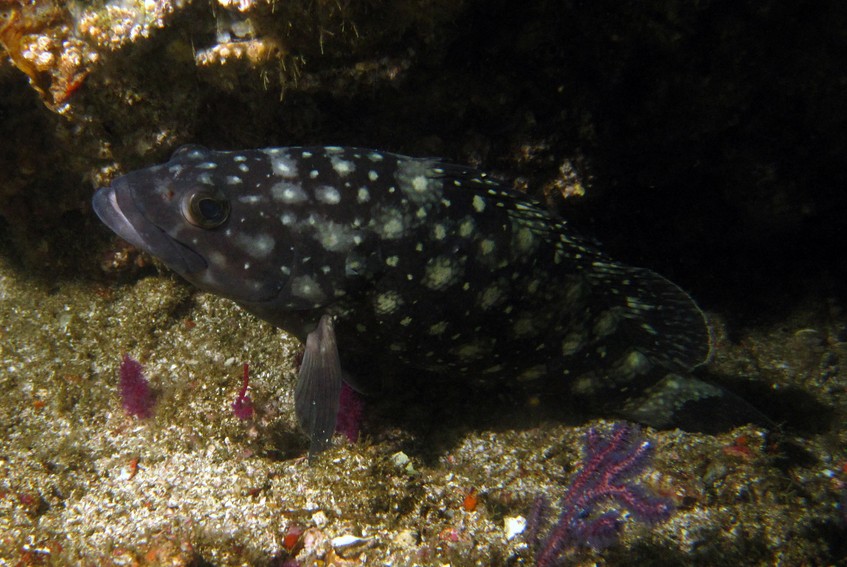EPINEPHELUS COERULEOPUNCTATUS - (Bloch, 1790)
Actinopterygii (Class) > Perciformes (Order) > Serranidae (Family) > Epinephelinae (Subfamily) > Epinephelus (Genus)
Mérou taches blanches, Vieille cuisinier, Loche à taches blanches, Vieille plate faraud, Ocellated rock-cod, Ocellated rockcod, Reef cod, Rock cod, Seabass, Small-spotted cod, Small-spotted rock cod, Snowy grouper, White-spotted grouper, White-spotted reef cod, White-spotted rockcod, Whitespotted grouper, Whitespotted rockcod, Hvidplettet havaborre, Garoupa manchas, Mero nevero,
Description
Épines dorsales (Total): 11; Rayons mous dorsaux (Total): 15-17; Épines anales 3; Rayons mous anaux: 8. Ce mérou possède une tête pointue et une grande queue arrondie qui le rendent facile à reconnaître. Sa robe est d'ailleurs caractéristique : le corps brun est couvert de taches blanches cernées de beige régulièrement réparties, et des taches blanches plus petites occupent les intervalles ; le pédoncule caudal est blanc, les nageoires noires finement liserées de blanc. Taille maximale : 76.0 cm TL. profondeur 2 - 65 m.
Etymologie
Epinephelus : du Grec [epi] = sur et [nephelus] = nuage, "couvert de nuages" pour décrire la robe du mérou.
coeruleopunctatus : du Latin [coerulus], bleu azur, et de [punctatus], ponctué, en référence aux points bleutés de sa robe.
Distribution
Indo-Pacifique : de l'Afrique de l'est jusqu'à l'Afrique du sud et jusqu'au Fidji et Tonga. Il est absent de Mer Rouge, mais il est présent dans le Golfe Persique et Oman. Présent en Nouvelle-Calédonie.
Espèces ressemblantes
Epinephelus ongus (Bloch, 1790) : Présent en Nouvelle-Calédonie.
Epinephelus corallicola (Valenciennes, 1828) : Présent en Nouvelle-Calédonie.
Epinephelus summana (Forsskål, 1775) : Présent seulement en Mer rouge et Golfe d'Aden.
Synonymes
Epinephelus caeruleopunctatus (Bloch, 1790)
Epinephelus caerulopunctatus (Bloch, 1790)
Epinephelus hoevenii (Bleeker, 1849)
Holocentrus coeruleopunctatus (Bloch, 1790)
Serranus alboguttatus (Valenciennes, 1828)
Serranus dermochirus (Valenciennes, 1830)
Serranus flavoguttatus (Peters, 1855)
Serranus hoevenii (Bleeker, 1849)
Serranus kunhardtii (Bleeker, 1851)
-----------------------------------------
Description
Dorsal spines (total): 11; Dorsal soft rays (total): 15-17; Anal spines: 3; Anal soft rays: 8. Characterized by brownish grey to charcoal color; head, body and dorsal fin with irregular-shaped white spots and blotches of variable size; adults with ctenoid scales on body in broad zone along middle of side, cycloid elsewhere; body of adult with numerous auxiliary scales; greatest depth of body 3.0-3.4 in SL; rounded caudal fin; short pelvic fins, 2.0-2.7 in head length; head length 2.3-2.5 times in SL; head pointed, interorbital area usually flat, and the dorsal profile almost straight; preopercle rounded, finely serrate; inconspicuous opercular spines; straight, sinuous or slightly concave upper edge of operculum; maxilla naked, mostly covered by upper lip; small or absent canines at front of jaws; 3-5 rows of small teeth in midlateral part of lower jaw. Max length : 76.0 cm. Depth range 2 - 65 m.
Etymology
Epinephelus: Greek, [epi] = on, and [nephelus] = cloud, "covered in clouds".
coeruleopunctatus : Latin [coerulus], azure-blue, and [punctatus], punctuate.
Distribution
Indo-Pacific: East Africa south to East London, South Africa and east to Fiji. Recently recorded from Tonga. It is not known from the Red Sea, but it does occur in the Persian Gulf. Record from northwestern Australia is doubtful. Reported from New Caledonia.
Biology
Occurs in rocky or coral-rich areas of deep lagoons, channels and outer reef slopes; usually in or near caves. Juveniles are found in tide pools. Feeds on fish (10 to 15% of its diet) and crustaceans (up to 70% of its diet). In Hong Kong live fish markets. Solitary.
Similar species
It is closely related to, and is often confused with, three other white-spotted species:
Epinephelus ongus (Bloch, 1790) : Reported from New Caledonia.
Epinephelus corallicola (Valenciennes, 1828) : Reported from New Caledonia.
Epinephelus summana (Forsskål, 1775) : Very similar to Epinephelus coeruleopunctatus which has longer pectoral fins, and a narrow white margin with broad blackish submarginal band on the median fins, which are absent or poorly developed in Epinephelus summana. Known only from the Red Sea and Gulf of Aden.
